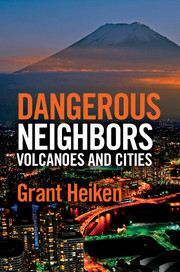‘Dangerous Neighbors: Volcanoes and Cities is a timely and authoritative wake-up call for over 60 global cities which Grant Heiken has identified within range of the world’s most dangerous active volcanoes. Devising effective disaster reduction measures for the wide range of volcanic hazards at these cities presents one of the greatest environmental challenges of our times.’
Peter J. Baxter - University of Cambridge, former Consultant Physician in Occupational and Environmental Medicine, and government and WHO health adviser
‘Since the beginning of the human race, volcanoes have fascinated us, giving inspiration to legends and beliefs, but they also pose serious threats to populations near and far. The examples included in this book have been carefully chosen to fully cover the wide spectrum of possible volcanic scenarios and to illustrate the different problems modern societies face in protecting themselves against volcanoes. Accessible to any interested readers, Heiken’s writing does not lack scientific rigour: this excellent book has the potential to rapidly become a bestseller among all those who work with and love volcanoes.’
Joan Martí - Institute of Earth Sciences Jaume Almera, Secretary General, IAVCEI, and Editor-in-Chief, Journal of Volcanology and Geothermal Research
‘In this excellent book, Heiken places the dangers and disaster potential of populated volcanoes within a varied context of local culture, geologic research, public planning and politics. Like great earthquakes, the world's great volcanoes are ticking time-bombs. This book is a must-read for anyone in the business of hazard forecasting, planning and mitigation in cities located near volcanoes.’
Erik Hauri - Carnegie Institution of Washington
‘Noted volcanologist Grant Heiken blends historical and archaeological evidence of past urban-volcanic interactions, and shows how current cultural practices and demographic trends shape how people can live with the threat of volcanic activity. This engaging and well-written book will be of interest to a variety of audiences from students with interests in volcano science, cultural anthropology, sustainability, and urban planning, to the general public wanting to learn more about how volcanoes affect our urban environment.’
Thomas Casadevall - Scientist Emeritus, US Geological Survey
'Not only is this a great book, but it would serve as a wonderful basis for a TV series of science documentaries. Heiken has more than 40 years' experience in studying volcanic hazards, and here he has chosen to write in detail about a dozen cities around the globe with histories of nearby volcanism and threat of future disaster.'
W. Dimmick - Central Connecticut State University
'… provides an integrated picture of how volcanic eruptions have affected cities in the past, and the lessons we can learn from these events to prevent death, disruption of life, and loss of property in the future. … The text is lively and the book is written in conversational style. It is also clear that the author has personally visited the sites discussed, and his affection for these settings comes through in his writing. The book is very accessible to the general reader, even if one has little scientific background. Terminology is explained and illustrated with clear examples.'
Risa Palm
Source: AAG Review of Books
'Grant Heiken, a world-renowned volcanologist, has written a book based on his long history investigating volcanic hazards that is absolutely riveting. Eight of the ten chapters focus on the interplay between major metropolises and destructive volcanoes … It deals at length with the quandary posed over how to educate the populous and government officials at all levels. Heiken also postulates how scientists can provide potential risk and hazard assessments in a manner that can be understood by the public … The book provides many great and in places dramatic photographs along with a chart listing large city populations and the last significant eruption by a nearby volcano. These are truly eye opening images. In addition, the frontispiece of the book contains definitions and descriptions of many volcanic phenomena central to understanding the book.'
Florie Caporuscio
Source: American Mineralogist





